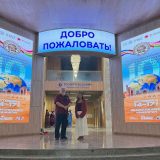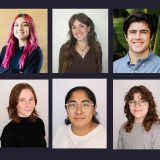TAB Journal Re-Envisioned
January 29, 2020
It’s been a big year for Tabula Poetica: The Center for Poetry at Chapman University. In December 2019, Southern California’s poetry community was on hand to contribute to the tenth anniversary of Tabula Poetica. Since its inception, Tabula Poetica has evolved from an annual reading series to include a poetry literary journal, launched in 2013.
A vessel for emerging and established poets, TAB: The Journal of Poetry and Poetics is the brainchild of Dr. Anna Leahy and Prof. Claudine Jaenichen. Many will be pleased to learn that after a hiatus from online issues last year, TAB is back. And has a whole new look.
Exploring poetry as a textual and material experience, Leahy said the aesthetic bent of TAB was never easy to isolate or pin down. “That’s purposeful on our part and probably sets us apart. A range of voices and approaches is what we’re building,” she said. Leahy also noted that TAB took its first steps on an open-source platform designed for scholarly journals, contributing a unique appearance and feel, but that the project has re-launched on the WordPress.org platform with greater accessibility and more design flexibility.
In fact, another quality that distinguishes TAB from other literary journals is the notable absence of uniformity concerning its design. Ever since their first print issue in January of 2013, TAB has resisted a predictable format. Recent editions have taken the form of maps, postcards, and one that unfolded in multiple directions, countering a prevailing orthodoxy about what a page looks like or means. “We play with concepts and constraints that shape the poetry reading experience,” Leahy said, and every January brings a brand-new issue of TAB in an unpredictable new format.
The innovative design of the 2020 print issue of TAB partly determined the contributors’ work. “We couldn’t consider just any poem,” Leahy said. “The poems had to fit the space.” But the asymmetricity of that issue, Leahy said, is also notable for its inclination toward California poets, including several of whom that visited Chapman’s campus as part of Tabula Poetica.
The rest of the year, TAB publishes online issues in alternating months. “We don’t aim to replicate a print journal on screen,” Leahy said. Instead, the staff considers the opportunities and limitations that the medium offers.
In 2020, Leahy wants to continue moving forward—with accessibility and disability playing increasingly essential roles in TAB. The journal did not publish any online issues last year so that the staff could update their archives of PDFs to improve their accessibility, making them amenable to electronic reading devices. Leahy accepted the risk of allowing the journal to take such a long intermission. “It was important for us to accomplish this necessary work,” she said.
The journal’s new website was built with an accessibility-ready template. This wasn’t easy. “Honestly, I hadn’t realized that not all WordPress templates are typically designed with accessibility in mind,” Leahy said. Rebuilding TAB from scratch was daunting. But she said this approach allowed them to design the website thoughtfully instead of making accessibility an add-on or an afterthought or to try to replicate the look of a previous platform. Jaenichen added: “With this year’s print issue, I’ve been driven to prioritize inclusive design principles.” Jaenichen agrees that these principles should not be afterthoughts or exceptions, “but the way we begin thinking about making work from the outset.”
Discussing the steps that TAB is taking in 2020 to make it more accessible to people with disabilities, Leahy said that the new print issue is driven by inclusive design and low-vision principles. Leahy and Jaenichen met with several people at the Braille Institute in 2019 to gain input on accessible design structures. “In the new issue,” Leahy said, “you’ll notice a larger, humanist-sans serif font, high contrast elements, color blocking—and a matte finish. Also, authors’ names and websites are added in Moon type, an embossed reading system for the blind from the nineteenth century that was easier to learn than Braille.”
But she understands persistent challenges: “Too often, accessibility is pitted against aesthetics. Or diversity is pitted against quality. We think that’s wrong-headed, and we’re out to show why. Accessibility and aesthetics go hand in hand at TAB, and so do diversity and quality.”
The staff continues working to make the journal and the poetry events engaging experiences. Leahy said: “We’ve included audio in online issues before, and we’re in the process of deciding how best to use it again going forward.” The Tabula Poetica Reading Series uses accessible event spaces and is currently looking into ASL interpretation for their reading series. But their budget is their biggest impediment. “We are committed to distributing TAB at no charge, and we don’t charge a submission fee,” providing another distinctive quality in a world where submitting your work can prove expensive. “That’s about accessibility too.”
With a new year comes newfound inspiration, and new ideas about keeping things fresh, to ensure that poetry is appreciated and accessible. “Claudine [Jaenichen] and I are engaging with each other and with others about what TAB can become,” Leahy said. Jaenichen wants to continue to improve the TAB journal experience, “with a focus,” she emphasizes, “on accessible principles.” Leahy and Jaenichen are confident about that future. “We’re rethinking the possibilities, Leahy said. “It’s an exciting change.”
TAB recently launched a new online platform at www.tabjournal.org. Follow on Facebook at https://www.facebook.com/TabPoetryJournal. Follow TAB on Twitter @TABJournal.


